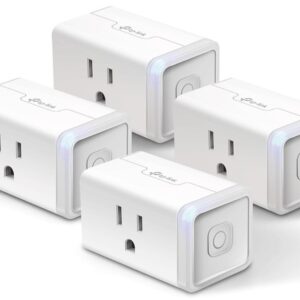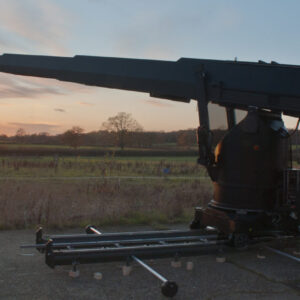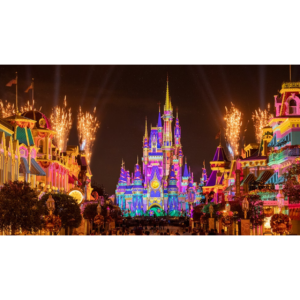By Robert Heron
robert@heronfidelity.com
March 22, 2024
Projection displays are the original big-screen viewing experience. As a display category, video projection setups present many technical options, including various screen materials, light sources, and pixel control technologies that, in addition to the room environment itself, contribute to the final quality of the image.
CONSIDERATIONS AND CONSTRAINTS
Before you consider investing in a projection setup, define your viewing goals. If you desire an immersive presentation, a supersized TV can deliver picture contrast and brightness that no consumer projector can match—and do so more effectively in typically lit room environments.
Projectors have a fixed amount of light output, and the larger the illuminated area, the dimmer the resulting picture will be – the good old inverse-square law in action. Projectors work best in rooms with effective ambient light control – pitch black is ideal. The darker the room, the more likely a projector will create a bright, well-detailed picture. Also, the closer a projector is to the screen, the brighter the picture. Conversely, the increased use of convenient lens functions like zoom or lens shift will decrease the projector’s light output.
Short-throw or ultra-short-throw (UST) projectors have become increasingly popular for their steadily improving performance and relatively compact space requirements. A UST projector is typically placed within inches of its screen, effectively eliminating the chance of a person being able to walk in front of the light source, disrupting the projected image. However, UST projectors are more prone to uniformity issues (mainly focus) than their long-throw counterparts.

Once you’ve decided on a room layout for your projection setup, consult a projector throw distance calculator to narrow your search of projectors (and their lens capabilities) that will work within your space. Projection calculators allow you to lock down any known values, such as the desired screen size or distance of the projector’s lens from the screen, to help you visualize how and if the chosen configuration will function within the given viewing area.
SCREEN TECH
You could point a projector at any relatively flat surface and see a usable picture. Still, a quality projection screen provides a neutrally colored and uniform surface ideal for producing seamless imagery from the projector’s output. Screen gain is a standard metric used to describe the performance of a particular projection screen. A screen gain of 1.0 is considered a neutral level of reflection that often features a very consistent and near-180-degree viewing angle. Screens that tout greater gain levels offer increased reflectivity, resulting in a brighter-looking picture. However, as screen gain increases, the trade-off is a narrowed viewing sweet spot and degraded picture uniformity due to hot-spotting in the projected image. Screens with gain ratings below 1.0 attempt to enhance the perceived black level of a projected image when operating in room environments with some ambient light.

The Silver Ticket Fixed Frame Projector Screen is an example of a neutral-gain screen with superb performance matching that of screens 10x the price. It’s also available in various screen sizes from 92 to 150 inches.
The extreme angle at which a UST projector’s output interacts with a screen surface often sees them paired with screens engineered to direct the reflected light toward the audience while rejecting other ambient light sources. Ambient light-rejecting (ALR) screens typically feature microscopic prism structures in a fresnel or lenticular-style pattern. Lenticular projection screens incorporate horizontal rows of angled wedge-shaped structures. The angled portion of this sawtooth-like structure is highly reflective and orientated toward the projector – the side opposite of this minimizes reflections from light sources above.

Fresnel ALR screens feature a similar sawtooth-like structure formed into a hemisphere of concentric rings emanating from the bottom-center edge of the screen – the ideal location for a UST projector. One advantage of fresnel ALR screens over lenticular designs is that they reject ambient light from the sides and above – including reflected glare from ceilings and walls. One disadvantage of fresnel ALR screens over lenticular designs is a more condensed viewing sweet spot – especially from the sides. Also, the directional nature of an ALR screen requires them to be inverted if a UST projector were to be ceiling mounted.

The Formovie Fresnel Ultra-thin ALR Projection Screen is among today’s best-performing screens for UST projectors – if its 100-inch size suits your setup.
LIGHT SOURCE
All projectors start with a light source that eventually transforms into the pixels we see reflected on the screen. High-pressure discharge lamps (sometimes called ultra-high-performance (UHP) lamps) have been the go-to light source for projection systems for the last 30 years. Filters transform the whiteish light from a UHP lamp into RGB (red, green, and blue) hues that the projector’s light engine uses to recreate the video source. More recently, laser emitters and LEDs can generate the light of primary colors directly and with increasing efficiency and longevity measured in the 10s of thousands of hours of operation – approximately ten times the lifespan of a UHP lamp module.

By © Raimond Spekking / CC BY-SA 4.0 (via Wikimedia Commons), CC BY-SA 4.0
Sometimes, projector manufacturers combine different light sources to reduce costs or overcome a design’s technical limitations. Early laser projectors started with a blue emitter that stimulated a phosphor material, generating a yellowish light. This yellowish light is then split into red and green and combined with the output from the blue laser to create a full-color image. More modern projectors have adopted RGB laser emitters or LEDs that can produce very wide color gamuts – the former now exceeding 100% of the BT.2020 color space featured in HDR10 and Dolby Vision video content.
PIXEL ENGINES
When controlling the luminance and defining the number of pixels in a projected image, projector manufacturers fall into two main technological camps: reflective and transmissive. Reflective pixel imaging technologies include TI’s DLP chipsets, which feature digital micromirror devices (DMDs) and liquid crystal on silicon (LCoS) chips – the latter used by companies like JVC and Sony in their premium projection products. LCD-based projectors would be considered transmissive imaging devices, including products using Seiko Epson’s popular 3LCD technology and the single LCD panels used in some value projection offerings.

DLP chipsets precisely actuate a million or more hinged microscopic mirrors at incredible speeds (100,000+ times per second), each modulating light onto one or several pixels depending on the chipset model. Projection LCoS chips feature an array of individually controlled pixels comprising a liquid crystal layer on top of a reflective base. By manipulating the liquid crystal layer, the LCoS chip can control the amount of light reflected by each pixel. DLP projectors dominate commercial digital cinema and the value home market. LCoS-based projectors, especially JVC’s, have wowed consumers with their best-in-class contrast performance.

PIXEL PROCESSING
All video projectors are either 1-chip or 3-chip designs. A 1-chip projector sequentially processes RGB (red, green, and blue) light at a high enough speed for our eyes to see it as a full-color image. 3-chip projectors process RGB color pixel information simultaneously through distinct light paths, combined into a full-color image. The sequential RGB light sources used with single-chip projectors, especially single-chip DLP-based projectors, can introduce color breakup artifacts (AKA rainbow effect) when displaying highly contrasted video material – some people are more sensitive to this artifact than others. A 3-chip projector avoids color breakup while offering measurably brighter color output than its single-chip brethren. Still, 3-chip projectors must be carefully tuned to minimize RGB convergence artifacts perceived as chromatic aberration (i.e., color fringing) – something single-chip projectors naturally avoid.

FUTURE TECH
Projector manufacturers will likely continue to adopt ever more efficient solid-state light sources like LEDs and lasers. In addition to this quest for a brighter picture and ever-higher resolutions (8K projectors arrive this year), the 2024 CES provided an opportunity to view a prototype projector in the Hisense booth built in collaboration with Barco. This DLP projector demonstration featured Barco’s “dynamic light steering” technology that concentrated the projector’s light output into the highlights of a video frame while reducing light in portions of the picture that should appear darker – increasing efficiency and improving peak brightness and picture contrast. The impressive demo claimed up to 2000 nits of peak light output and could operate on a per-frame or per-scene basis – it was pure eye candy.

Robert is a technologist with over 20 years of experience testing and evaluating consumer electronics devices, primarily focusing on commercial and home theater equipment.
Robert's expertise as an audio-visual professional derives from testing and reviewing hundreds of related products, managing a successful AV test lab, and maintaining continuous education and certifications through organizations such as CEDIA, the Imaging Science Foundation (ISF), and THX.
More recently, Robert has specialized in analyzing audio and video display systems, offering comprehensive feedback, and implementing corrective measures per industry standards. He aims to deliver an experience that reflects the artists' intent and provides coworkers and the public with clear, insightful product information.










